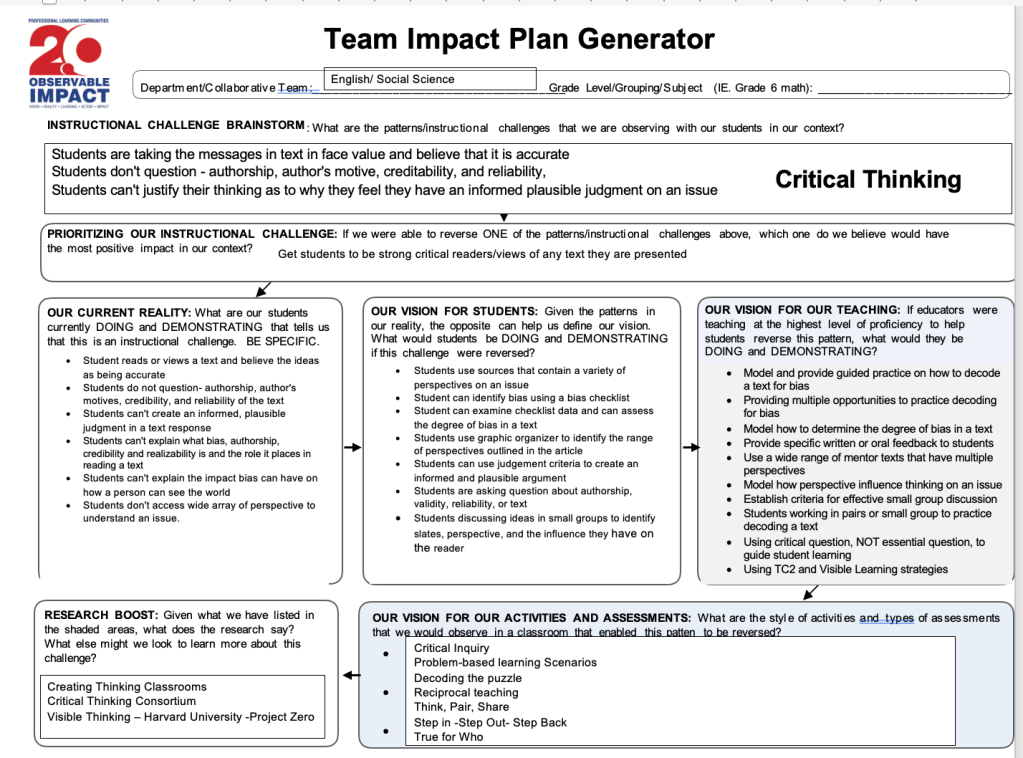How many of you have attended professional development (PD) sessions at a school, division/district, province/state, national or international level? Okay, get your hands up so I can see them. A big question is coming, so get ready. How many of you implemented the professional learning from these sessions as soon as you got back to class? Raise your hand nice and high so that I can see them. Hmm, I am having trouble seeing a sea of hands from where I am sitting. How many of you put the professional development information into a filing cabinet drawer only to find it in August when you were purging for the new school year? Ah, I see quite a few more hands raised. Is your head spinning as you read this because reflecting on the number of PD sessions you have attended, you recognized that only a tiny amount of this PD is present in your classroom practices? I can count on one hand, after twenty-eight years of teaching, the PD that is still prevalent in my instructional toolkit. In my career, I have attended numerous professional development learning opportunities. Many have taken place at a school, divisional, and provincial level, and I have also been lucky enough to participate in national and international conferences. Still, if I asked myself, what has been the observable impact of these professional development learning experiences on students and my instructional practices, my honest response would be meagre when I look at the volume of PD that I have attended.
So my next question is – why? In my opinion, the mandatory PD that I have attended reflects a flavour-of-the-year approach, much like the release of a new American Girl doll. There was an exciting and splashy reveal but come the following year, we were introduced to the next new shiny topic. So in this blog post, I will introduce you to the concept of Observable Impact (OI). I believe it is the most powerful staff capacity-building framework that I have used. Observable Impact honours teacher expertise and adult learning needs, provides targeted and pragmatic collaborative educator learning opportunities, develops powerful teacher networking, and uses data in a productive versus cumbersome and intrusive manner. Ultimately, it bring about positive growth in educators’ instructional practices and student achievement.
As I have already mentioned, I am a proud educator with twenty-eight years of experience. For the last 15-plus years, I have been an instructional coach in two different high schools in my division. As you can imagine, I have seen innovations come and go as predictably as the sun rises in the east and sets in the west. Over this period, vast amounts of the provincial government and divisional money have been spent on innovations: new report cards, new curricula, policy, professional development, and resources. I have experienced a great deal of staff capacity-building professional development on Response to Intervention (RT), which I wrote about in some previous blog posts. I had great expectations that this framework would bring about high growth in teacher efficacy, but what I have found is that RTI is rich in structures but very low on function. I want to be crystal clear; collaborative professional development is the heartbeat of staff capacity development. I propose that too often, teacher professional development focuses on what we will do (actions) instead of what we will see (impact) as a result of what we do. As a result of this action-oriented thinking, educators attend vast quantities of professional development opportunities. Still, the PD implementation in the classroom is shallow, which equates to little impact on student learning. What is equally concerning is that PD with an unclear purpose to educators often produces deep-seated apathy. When adult learners do not see the “why” of PD, and the initiative lacks any practical application to the teachers’ context, and the PD has a top-down appearance, educators walk away frustrated and perplexed.
As this point, I need to introduce you to Mr. Cale Birk, Observable Impact – Global Director of the Learning. I serendipitously met Cale approximately three years ago at a professional development workshop that I attended. We struck up a conversation and over the past three years, we have continued conversing about staff capacity building even though we live 18 hours from each other. Through these conversations, I was introduced to the concept of Observable Impact. Observable impact is “changes in practice that are visible in the classroom and lead to improved student outcomes (Birk & Larson, 2019, p. 21). In fifteen years of being a continuous improvement coach, I have never had such clarity in facilitating staff growth. I am genuinely ecstatic. I can foresee teachers embracing professional collaboration because they are addressing challenges in their classroom that are draining them of physical and mental energy. I see the growth of teacher efficacy and the development of powerful teacher networks. The Observable Impact process focuses on five key questions:
- What’s our observable vision of a learner?
2. What’s our evidence-based reality?
3 What’s our learning?
4. What’s our action?
5. What’s our impact?
Below is a snapshot of the Team Impact Generator (TIG) protocol that guides a teacher team in developing an observable impact instructional plan to address an instructional challenge in the classroom. This process is driven by teachers, which addresses critical aspects of adult learning theory. A collaborative teacher team must first narrow down a specific instructional challenge that they are dealing with in the classroom. Using this collaboratively agreed upon instructional challenge, the teacher team then paints a picture of their current reality connected to this instructional challenge. They must identify specific evidence of what students are doing and demonstrating in the classroom that makes this an instructional challenge. What would we see, hear, observe students doing? Educator teams provide concrete and observable evidence. This is important because until we get visually specific, how will we know what is breaking down and what the next steps must look like? Looking at achievement data will not provide this critical, detailed information, a cornerstone of the RTI process. The second column requires teachers to take each pattern point in column one and provide the opposite to develop a vision of what students should be doing and demonstrating. Again, these pragmatic statements need to be highly observable. Finally, the shaded column identifies what educators would be doing and demonstrating at the highest level of proficiency to help students revise the pattern. Innovations such as Response to Intervention omit this critical part of the learning process and instead solely focus on student achievement data. In my experience, the RTI framework assumes that by looking at data, teacher’s instructional practices will improve, and by looking at data teachers will be able to identify where instruction is breaking down. This is a very cumbersome and time consuming process that provides low return of investment. The this column of the Team Impact generator draws upon teacher expertise but also supports teachers in looking at evidence-based resources to uncover new practices. In this approach, both stakeholders – students and teachers – are expected to demonstrated growth.
The Observable Impact process requires teachers to identify what they need to do and demonstrate in the classroom. As you can see in the example, there is a long list of observables, which can’t possibly be tackled all at once. Instead of overwhelming teachers, the teacher team is asked to prioritize which one or two observable impact statement(s) in the third column would be the best starting point to chip away at the instructional challenge. We usually start with low-lying fruit that won’t overwhelm the teacher but enable them to see some positive growth in students’ skill or knowledge repertoire. I believe these steps are CRITICALLY missing in the past and present innovations, such as Teaching Sprints and Response to Intervention. I have found this process efficient and brings much-needed clarity on what areas the team needs to focus their energies on in a manageable manner. Please see the Team Impact Plan Generator protocol example below for critical thinking that I used with a teacher.
Suppose I wanted you, my colleagues, to come into my classroom at different times throughout my unit to provide feedback on the specific target we selected. Would you be able to document what you see, hear, and observe me and the students doing around that specifically identified target ? Would you be able to determine the degree of impact the instructional strategies I am using have on moving students toward the vision of a learner? My point is that focusing on Observable Impact provides a clear driver for growth. Observable Impact is driven by function, and structure are build to support the function. Function is the heartbeat of systemic change, which I believe teachers want to focus on and improve.
For our school plan, we are developing a Team Impact Generator on formative assessment. I look forward to providing you with year-long updates into 2021-2022 on the school-wide implementation of using the Observable Impact approach.
Stay tuned! If you have any questions, please feel free to leave your comments below.
All the best,
Ingrid




Leave a comment